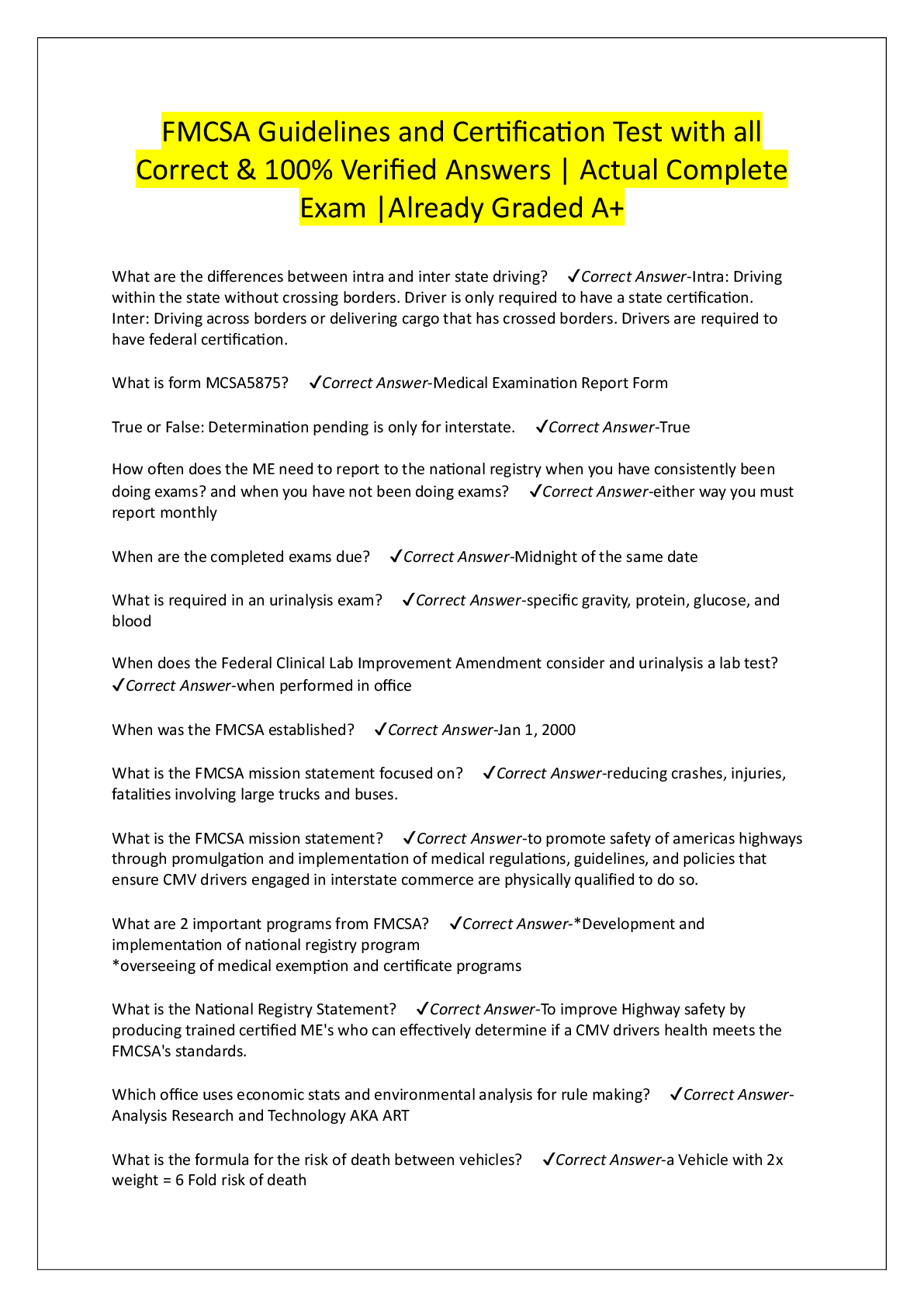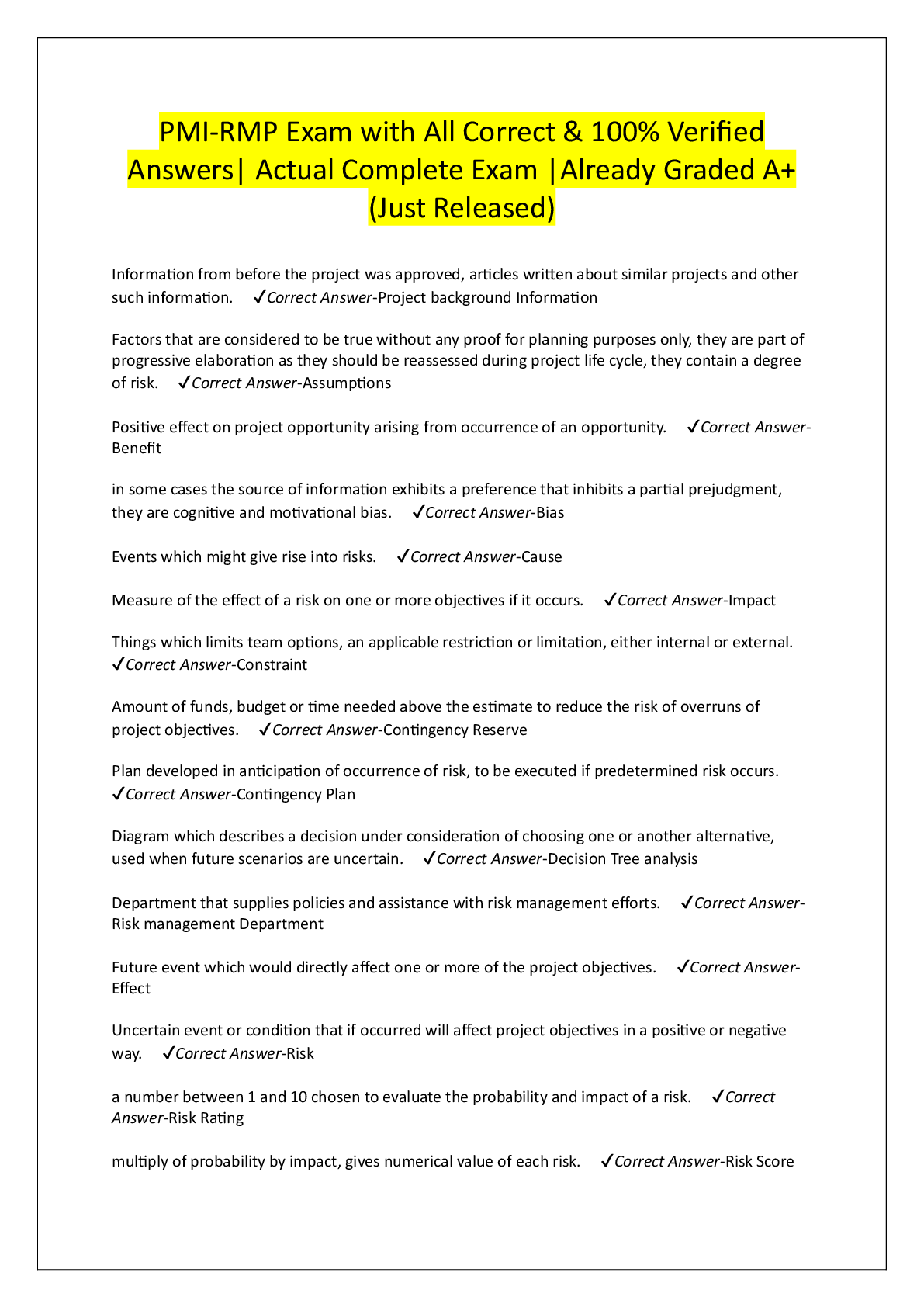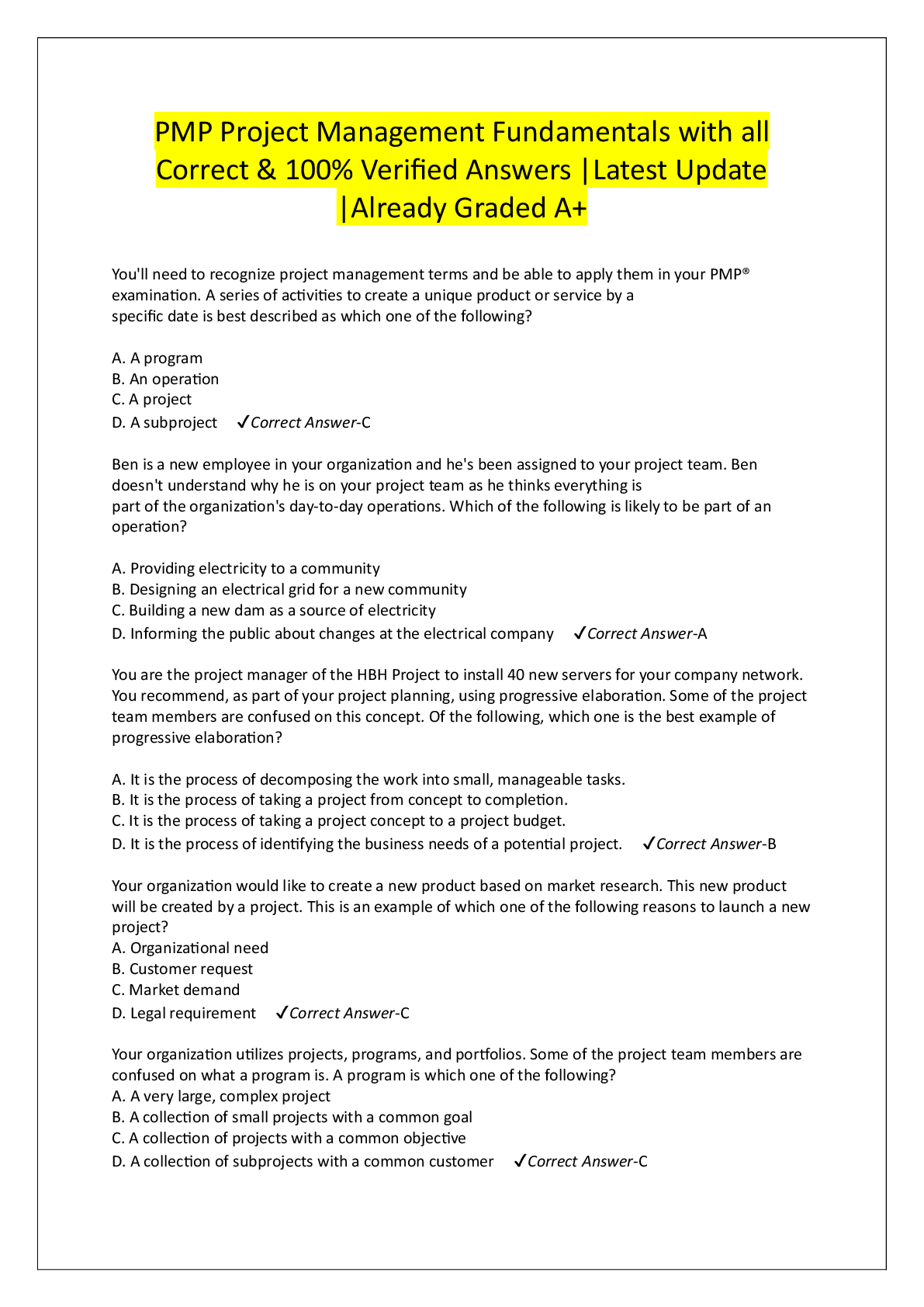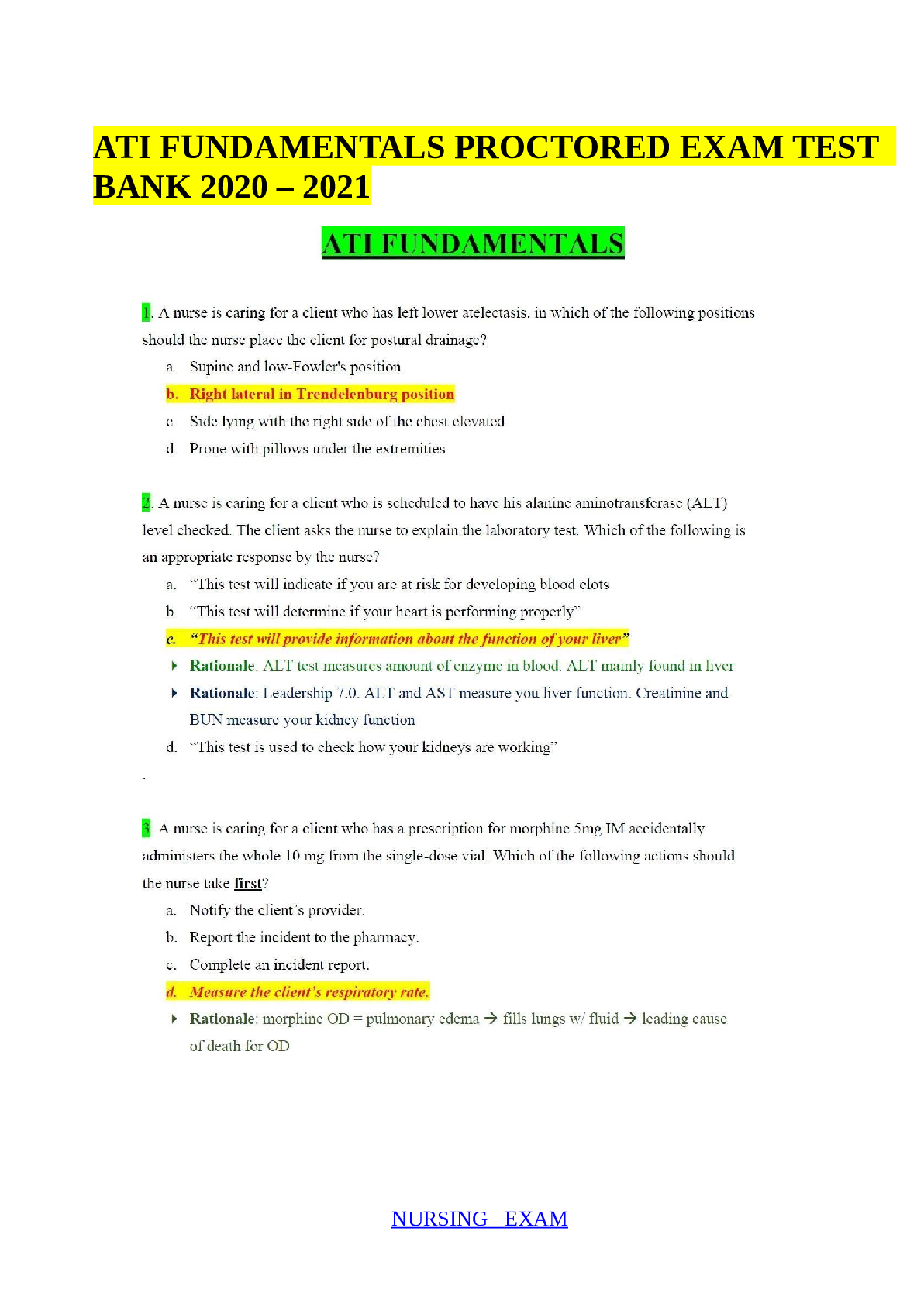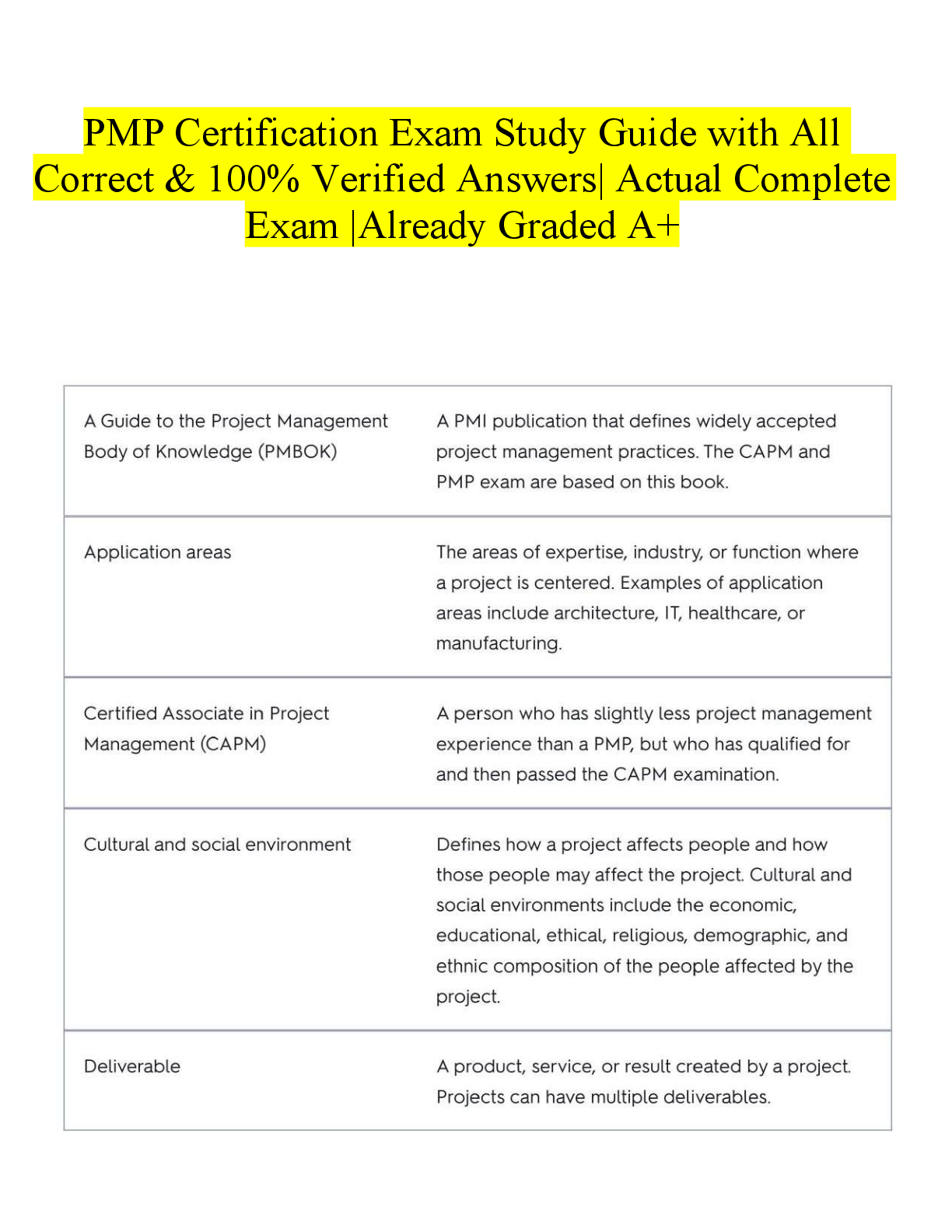BSTAT 3321 / BSTAT3321 Practice Final Exam
Document Content and Description Below
BSTAT 3321 Practice Final Exam
1. The two graphical techniques we usually use to present nominal data are
a. bar chart and histogram
b. pie chart and ogive
c. bar chart and pie chart
d. histo
...
gram and ogive
2. Which of the following are deceptive practices
a. Using a pie chart instead of a bar chart
b. Using a bar chart instead of a line graph
c. Showing only absolute changes in value with a truncated vertical axis
d. All of the above are deceptive
3. In a positively-skewed distribution,
a. the median equals the mean
b. the median is less than the mean
c. the median is larger than the mean
d. the mean, median, and mode are equal
4. The Empirical Rule states that the percentage of measurements in a data set (providing that the data set has a bell-shaped distribution) that fall within two standard deviations of their mean is approximately:
a. 68%
b. 75%
c. 95%
d. 99.7%
5. Which of the following statements is true for the following data values: 7, 5, 6, 4, 7, 8, and 12?
a. The mean, median and mode are all equal
b. Only the mean and median are equal
c. Only the mean and mode are equal
d. Only the median and mode are equal
6. Which of the following sampling plans does not use random methods of selections?
a. Simple random sampling.
b. Stratified random sampling.
c. Random cluster sampling.
d. Self- selected opinion poll. (SLOP)
7. If two events are mutually exclusive, what is the probability that both occur at the same time?
a. 0.00
b. 0.50
c. 1.00
d. Cannot be determined from the information given.
8. If A and B are independent events with P(A) = 0.20 and P(B) = 0.60, then P(A|B) is:
a. 0.20
b. 0.60
c. 0.40
d. 0.80
9. The number of fans at a Cowboy’s game over a given time interval is an example of a(n) __________ random variable. The length of the game in minutes is an example of a(n) _________random variable.
a. Exponential; Poisson
b. Continuous; discrete
c. Discrete; Continuous
d. None of the above
10. The probability of 3 or fewer heads in 10 tosses of an unbiased coin is
a. .117
b. .883
c. .172
d. None of the above
11. Airlines always overbook because of no shows. The probability of a no show for a reservation is .10. If a flight has 100 reservations, what is the expected number of passengers who will actually show up? What is the variance of the number of passengers who actually show up?
a. 10,100
b. 90, 9
c. 10, 9
d. None of the above
12. Given that the random variable X is normally distributed with a mean of 75 and a standard deviation of 5, P (65<X<85)?
a. 0.3413
b. 0.6826
c. 0.9544
d. None of the above
13. Random samples of size 49 are taken from an infinite population whose mean is 300 and standard deviation is 21. The mean and standard error of the sample mean, respectively, are:
a. 300 and 21
b. 300 and 3
c. 70 and 230
d. 49 and 21
14. An infinite population has a mean of 60 and a standard deviation of 8. A sample of 50 observations will be taken at random from this population. The probability that the sample mean will be between 57 and 62 is
a. 0.9576
b. 0.9960
c. 0.2467
d. 0.3520
15. The Central Limit Theorem states that, if a random sample of size n is drawn from a skewed population, then the sampling distribution of the sample mean :
a. is approximately normal if n > 30
b. is approximately normal if n < 30
c. is approximately normal if the underlying population is normal
d. has the same variance as the population
16. Suppose that student debt for students at UTA follows a positively skewed distribution with mean of $9,000 and a standard deviation of $3,000. If 30 students are randomly sampled, which statement about the sampling distribution of the sample mean is not true
a. The expected value of the sampling distribution of the sample mean is $9,000
b. The standard error of the sampling distribution of the sample mean is $547.72
c. The shape of the sampling distribution of the sample mean is approximately normal
d. None of the above
17. A sample of 250 observations will be selected at random from an infinite population. Given that the population proportion is .25, the standard error of the sampling distribution of the sample proportion is:
a. 0.0274
b. 0.5000
c. 0.0316
d. 0.0548
18. The criterion for using the normal distribution to approximate the sampling distribution of the sample proportion is
a. n > 30
b. n* > 5 and n*(1-) > 5
c. Either of the above
d. Both of the above
19. A 98% confidence interval estimate for a population mean is determined to be 75.38 to 86.52. If the confidence level is reduced to 90%, the confidence interval for
a. becomes wider
b. remains the same
c. becomes narrower
d. None of the above.
20. To estimate with 99% confidence the mean of a normal population, whose standard deviation is assumed to be 6 and the maximum allowable sampling error is assumed to be 1.2, requires a random sample of size
a. 166
b. 165
c. 164
d. 163
21. Under which of the following circumstances is it impossible to construct a confidence interval for the population mean?
a. A non-normal population with a large sample and an unknown population variance
b. A normal population with a large sample and a known population variance
c. Non-normal population with a small sample and an unknown population variance
d. A normal population with a small sample and an unknown population variance
22. A confidence interval was used to estimate the proportion of international students. A random sample of 72 students generated the following 90% confidence interval: (0.438, 0.642). Using the information above, what size sample would be necessary if we wanted to estimate the true proportion to within 0.08 using 95% confidence?
a. 105
b. 150
c. 420
d. 597
23. A university dean is interested in determining the proportion of students who receive some sort of financial aid. Rather than examine the records for all the students, the dean randomly selects 200 students and finds that 118 of them are receiving financial aid. The 95% confidence interval for is 0.59 0.07. This interval can be interpreted:
a. we are 95% confident that the true proportion of all students receiving financial aid is between 0.52 and 0.66.
b. 95% of the students get between 52% and 66% of their tuition paid for by financial aid.
c. we are 95% confident that between 52% and 66% of the sampled students receive some sort of financial aid.
d. we are 95% confidence that 59% of the students are on some sort of financial aid.
24. A Type I error is committed if we make:
a. a correct decision when the null hypothesis is false
b. a correct decision when the null hypothesis is true
c. incorrect decision when the null hypothesis is false
d. incorrect decision when the null hypothesis is true
25. In a criminal trial, a Type II error is made when:
a. a guilty defendant is acquitted
b. an innocent person is convicted
c. a guilty defendant is convicted
d. an innocent person is acquitted
26. Which of the following statements is not true about the level of significance in a hypothesis test?
a. The larger the level of significance, the more likely you are to reject the null hypothesis
b. The level of significance is the maximum risk we are willing to accept in making a Type I error
c. The significance level is also called the level
d. The significance level is another name for Type II error
27. Researchers determined that 60 Kleenex tissues is the average number of tissues used during a cold. Suppose a random sample of 100 Kleenex users yielded a mean number of 54 tissues used during a cold. Give the null and alternative hypotheses to determine if the number of tissues used during a cold is less than 60.
a. and
b. and
c. and
d. and
28. The p-value criterion for hypothesis testing is to reject the null hypothesis if:
a. p-value =
b. p-value <
c. p-value >
d. - < p-value <
29. Suppose you are testing the null hypothesis that no more than half the countries in the world are predominantly Christian. A random sample of 30 countries has 18 that are predominantly Christian. What is the p-value for your test?
a. .8643
b. .1357
c. .2714
d. None of the above
30. In the above problem, at the 5% significance level the null hypothesis
a. would be rejected since 18 is more than half of 30
b. would not be rejected since the observed Zstat is less than the critical Z
c. would be rejected since the p-value > .05
d. None of the above
31. A regression analysis between sales (in $1000) and advertising (in $) resulted in the following least squares line: = 80,000 + 5x. This implies that an:
a. increase of $1 in advertising is expected, on average, to result in an increase of $5 in sales
b. increase of $5 in advertising is expected, on average, to result in an increase of $5,000 in sales
c. increase of $1 in advertising is expected, on average, to result in an increase of $80,005 in sales
d. increase of $1 in advertising is expected, on average, to result in an increase of $5,000 in sales
32. In the least squares regression line = 3 - 2x, the predicted value of y equals:
a. 1.0 when x = -1.0
b. 2.0 when x = 1.0
c. 2.0 when x = -1.0
d. 1.0 when x = 1.0
33. Testing whether the slope of the population regression line could be zero is equivalent to testing whether the:
a. sample coefficient of correlation could be zero
b. standard error of estimate could be zero
c. population coefficient of correlation could be zero
d. sum of squares for error could be zero
34. In a regression problem, if the coefficient of determination is 0.95, this means that:
a. 95% of the y values are positive
b. 95% of the variation in y can be explained by the variation in x
c. 95% of the x values are equal
d. 95% of the variation in x can be explained by the variation in y
35. Which of the following assumptions concerning the probability distribution of the random error term is stated incorrectly?
a. The distribution is normal
b. The mean of the distribution is 0
c. The variance of the distribution increases as x increases
d. The errors are independent
36. In a simple linear regression problem, r and
a. may have opposite signs
b. must have the same sign
c. must have opposite signs
d. must be equal
37. If the coefficient of correlation is 0.90, then the percentage of the variation in the dependent variable y that is explained by the variation in the independent variable x is:
a. 90%
b. 81%
c. 0.90%
d. 0.81%
38. In order to estimate with 95% confidence the expected value of y for a given value of x in a simple linear regression problem, a random sample of 10 observations is taken. Which of the following t-table values listed below would be used?
a. 2.228
b. 2.306
c. 1.860
d. 1.812
39. The confidence interval estimate of the expected value of y for a given value y x, compared to the prediction interval of y for the same given value of x and confidence level, will be
a. wider
b. narrower
c. the same
d. impossible to know
40. The width of the confidence interval estimate for the predicted value of y depends on
a. the standard error of the estimate, Syx
b. the value of x for which the prediction is being made
c. the sample size
d. All of the above
[Show More]
Last updated: 3 years ago
Preview 1 out of 3 pages

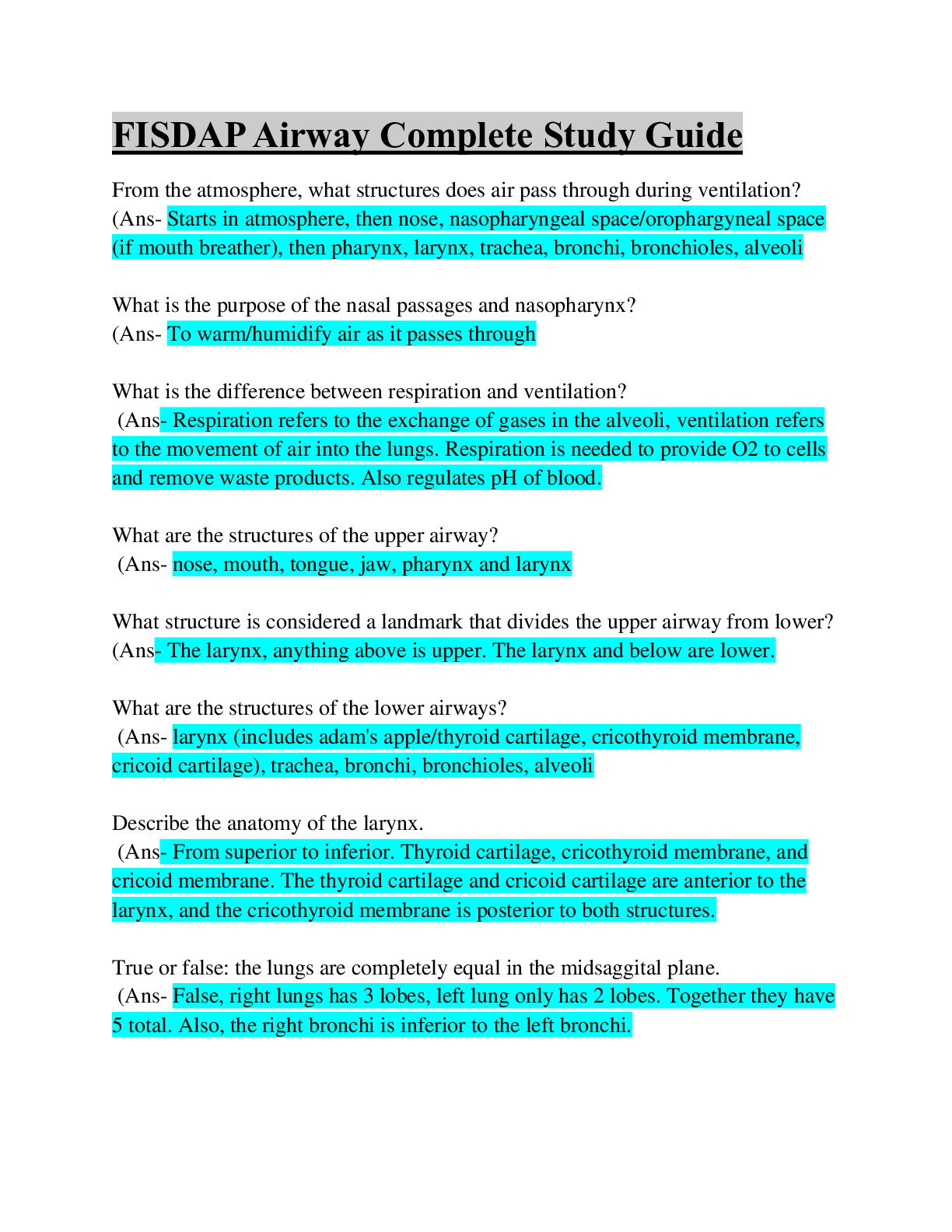


.png)


.png)












